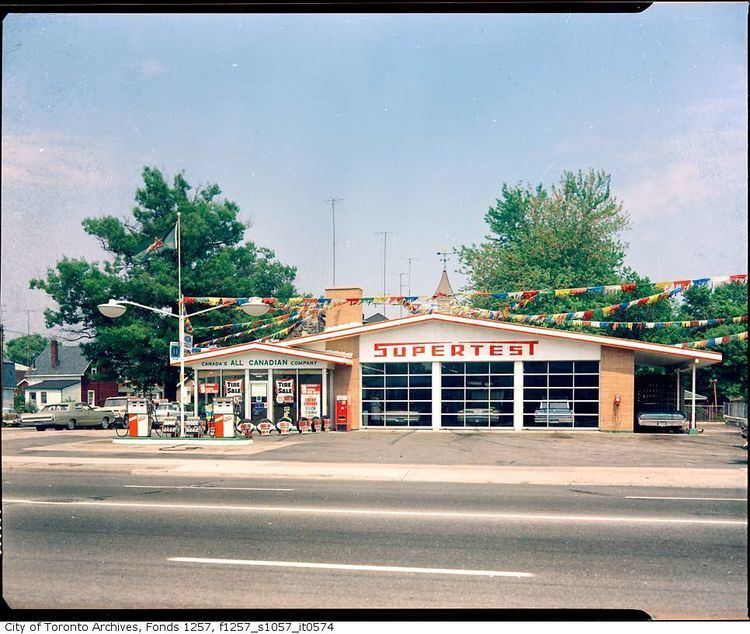Type Subsidiary Founded 1953 Parent organization BP | Industry Oil and gas Headquarters Calgary | |
 | ||
Predecessor Supertest Petroleum Corporation CEO Christina Verchere (1 Apr 2012–) | ||
BP Canada Energy Group ULC (commonly, BP Canada), is a Canadian oil and gas company headquartered in Calgary, Alberta, and a subsidiary of BP plc (formerly named British Petroleum).
Contents
- History
- Heritage through Supertest Petroleum 1923 1992
- Heritage through Amoco 1926 present
- Operations
- References
The present day BP Canada was created after a long history of joint ventures, mergers, spin-offs, and the amalgamation of a number of companies - which include the 1982 divestment of its downstream assets to Petro-Canada, and the 1992 demerger of its upstream division into Talisman Energy Inc.
As of 2012, following the divestment of its natural gas and natural gas liquids businesses, current BP operations in Canada focus on oil sands, including joint ventures with companies including Husky Energy and Devon Energy. It has activities in Alberta, the Northwest Territories, and offshore in Nova Scotia and the Canadian Beaufort Sea, and as of 2012 employed more than 450 employees.
History
The present day BP Canada was created over the years from merging and spinning-off of a number of companies. The predecessor companies of BP Canada include;
Heritage through Supertest Petroleum (1923-1992)
One major predecessor of the company traces to the Supertest Petroleum Corporation, founded in 1923 and headquartered in London, Ontario. In 1953, British Petroleum Company (BP) entered the Canadian market through the purchase of a minority stake in Calgary-based Triad Oil Company. In the early 1950s, the power struggle between oil companies and host governments in Middle East started, which hampered operations of British Petroleum in the region, and prompted it to diversify its operations beyond the heavily Middle East dependent oil production. The Canadian holding company of British Petroleum was renamed BP Canada in 1969; and in 1971, it acquired 97.8% stake of Supertest. Subsequently, Supertest was renamed to BP Canada Ltd, and other Canadian interests of British Petroleum amalgamated to the new company.
BP retail operations disappeared from Canada in the early 1980s, when in 1982, BP Canada divested its downstream assets to Petro-Canada, which was at the time owned by the Government of Canada. In 1992, British Petroleum sold off its 57% stake in BP Canada Ltd to the public, and BP Canada demerged into Talisman Energy Inc.
Heritage through Amoco (1926-present)
Through the 1998 acquisition of the global operations of Amoco (formerly Standard Oil of Indiana) by British Petroleum, BP Canada acquired the assets of former major Canadian oil and gas companies, including Dome Petroleum and Hudson's Bay Oil and Gas Company. The heritage traces back through a history of joint ventures, mergers and acquisitions to the year 1926, when the oldest commercial corporation in North America, Hudson's Bay Company, co-founded Hudson's Bay Oil and Gas Company (HBOG) with Marland Oil Company. Later, Marland oil merged with Conoco in 1929. HBOG expanded during the 1940s and 50s, and in 1960 began shipping Canadian crude to a refinery in Billings, Montana through a new link to the Glacier pipeline. The company became the sixth-largest Canadian producer in 1967. In 1973, HBOG acquired 35% stake in Siebens Oil and Gas, but by 1979 it divested its interest.
In 1980, HBOG bought a controlling interest in Roxy Petroleum. In the 1980s, sales and oil prices slipped, while debt from acquisitions piled up which led Hudson's Bay Company to sell off its 52.9% stake in HBOG to Dome Petroleum. However, as a result of the 1986 drop in world oil prices and substantial debts from past takeovers, Dome Petroleum became an acquisition target. In November 1987, after months of negotiation, an agreement in principle was reached with Amoco Canada Petroleum Co Ltd for buying Dome for US$5.5 billion. The purchase was completed on 1 September 1988.
In 1998–2000, the operations of Amoco, ARCO and Burmah Castrol were amalgamated. Into the 2000s, BP Canada operated primarily as a producer of natural gas and employed more than 2000 employees.
The company partnered with Imperial Oil beginning in 2010, to carry out exploration of two of its offshore oil and gas blocks in the Beaufort Sea. During 2010 and 2011, BP Canada sold its natural gas operations as part of divestments following the Deepwater Horizon oil spill. It sold its natural gas business in Alberta and British Columbia to Apache Corporation in July 2010 and its Canadian natural gas liquids business to a subsidiary of Plains All American Pipeline in December 2011.
Operations
The company operates primarily in Alberta, the Northwest Territories, and Nova Scotia. As of 2012, BP Canada has approximately 450 employees. It purchases crude oil for the company's refineries in the US, has oil sands holdings in Alberta and four offshore blocks in the Beaufort Sea and Nova Scotia. The company's oil sands leases include joint ventures with Husky Energy in the Sunrise Energy Project (50%), and Devon Energy in Pike, and a partnership with Value Creation Inc. in the development of the Terre de Grace oil sands lease. The Sunrise oil sands project entered the development phase in 2012. As of 2012, the Pike project, was in the regulatory approval phase, and the Terre de Grace project was in the resource appraisal phase.
